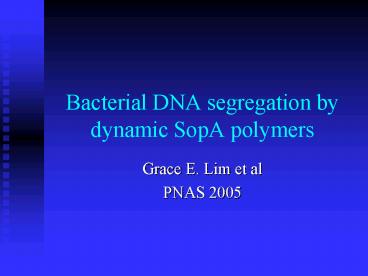Bacterial DNA segregation by dynamic SopA polymers - PowerPoint PPT Presentation
1 / 24
Title:
Bacterial DNA segregation by dynamic SopA polymers
Description:
Many bacterial plasmids and chromosomes rely on ParA ATPase for proper ... FRAP was therefore used to determine the rate at which subunits within the SopA1 ... – PowerPoint PPT presentation
Number of Views:259
Avg rating:3.0/5.0
Title: Bacterial DNA segregation by dynamic SopA polymers
1
Bacterial DNA segregation by dynamic SopA polymers
- Grace E. Lim et al
- PNAS 2005
2
abstract
- Many bacterial plasmids and chromosomes rely on
ParA ATPase for proper positioning within the
cell and for efficient segregation to daughter
cells. - The authors demonstrate that the F-plasmid
partitioning protein SopA polymerizes into
filaments in an ATP-dependent manner in vitro,
and that the filaments elongate at a rate that is
similar to that of plasmid separation in vivo.
3
- The authors show that SopA is a dynamic protein
within the cell, undergoing cycles of
polymerization and depolymerization, and
shuttling back and forth between nucleoprotein
complexes that are composed of the SopB protein
bound to SopC-containing plasmids. - The dynamic behavior of SopA is critical for
Sop-mediated plasmid DNA segregation . - The authors also show that SopA colocalizes with
SopB/SopC in the cell and that SopB/SopC
nucleates the assembly of SopA and is required
for its dynamic behavior .
4
- The authors propose a mechanism in which plasmid
separation is driven by the polymerization of
SopA , and they speculate that the radial
assembly of SopA polymers is responsible for
positioning plasmids both before and after
segregation.
5
introduction
- Chromosome segregation in eukaryotes is mediated
by dynamic proteins such as tubulin, which
polymerize into filamentous structures that are
capable of rapid reorganization by means of
cycles of depolymerization and repolymerization. - Although much less is understood about the
mechanism of DNA segregation in bacteria, dynamic
bacterial actin homologues have recently been
shown to play an important role in the process.
6
- One of the first DNA segregation systems to be
identified in E. coli was the F plasmid Sop
system, which consists of two protein
components, SopA and SopB, and a cis-acting DNA
sequence, sopC. - Plasmids containing different ParA systems
localize to distinct midcell positions and
separate at different times, suggesting that
different Par systems function independently from
each other for both positioning and separation.
7
- A distant ParA relative, ParF of plasmid TP228,
was recently shown to assemble into polymers in
vitro, suggesting that, as in the case of the
actin-like ParM, polymerization might provide the
driving force for plasmid segregation.
8
Result 1
- Purified SopA Assembles into Polymers in Vitro.
9
SopA was tagged at its N terminus with
hexahistidine and purified over a nickel affinity
gel column. When incubated with ATP, SopA
polymerized into long filaments, a process that
could be visualized in the fluorescence
microscope when the protein was stained with the
nonspecific stain Nile red.
10
The distance between the ends of six growing
filaments were measured. The average elongation
rate for the six filaments is 0.18µm/min. These
rates are similar to those at which bacterial
plasmids and chromosomal DNA have been observed
to separate in vivo during segregation.
11
- These findings suggest that SopA polymerization
might be an integral part of the mechanism by
which plasmid DNA is segregated within the cell.
12
Result 2
- SopA-GFP Assembles into Polymers Within the Cell.
13
When expressed in the presence of all three sop
components, SopA-GFP gave rise to a complex
pattern of intracellular fluorescence. Most cells
contained discrete foci (60 Fig. 2B) or a
nonuniform haze of fluorescence (35 Fig. 2 C
and D).
14
- The haze typically took the form of a symmetric
midcell peak that dropped off in intensity toward
the two poles (Fig. 2C) or a quarter-cell peak
with an asymmetric haze that extended toward the
opposite pole (Fig. 2D). Some cells contained two
foci connected by a central haze(Fig. 2E).
15
The authors monitored these F cells with
time-lapse microscopy. In nearly all of the
cells, SopA-GFP oscillated between the
quarter-cell positions with a period of 20 min .
This oscillation might correspond to cycles of
SopA polymerization and depolymerization.
16
Result 3
- SopA Colocalizes with SopB in the Cell.
The authors found that 94 of the SopA-GFP foci
were coincident with SopB-CFP foci. This finding
demonstrated that SopA-GFP does assemble at the
plasmid and that SopA and SopB likely interact at
the plasmid in vivo.
17
Result 4
- SopB and sopC Nucleate SopA Assembly in Vivo.
18
Result 5
- SopB Nucleates Assembly of SopA into Radial
Asters in Vitro.
19
Result 6
- Identification of a SopA Mutant Affecting
Polymerization and Segregation.
In the course of constructing SopA-GFP, the
authors isolated a mutant (SopA1-GFP) that formed
long filaments in most cells even in the absence
of the other sop genes.
20
- FRAP was therefore used to determine the rate at
which subunits within the SopA1-GFP filaments
exchanged with subunits from the cytoplasmic
pool.
21
SopA1 was able to trap the ordinarily dynamic
wild-type SopA into static filaments.
22
A shift from dynamic to static SopA assembly
disrupts the function of the Sop plasmid
segregation system.
23
New Model
Proposed mechanism for plasmid segregation as
mediated by the Sop system.
24
Thanks!

